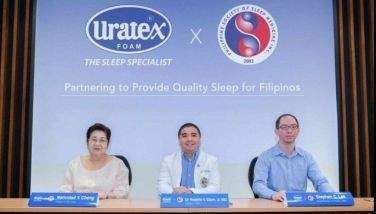How healthy is the state of our nation?
As we go to press Sunday, President Gloria Macapagal has yet to deliver her State of the Nation Address (SONA) Monday, July 27. Though a day late (better late than never), we’re sharing this open letter with our readers:
Dear colleagues and friends,
Thoughts on President Gloria Macapagal Arroyo’s State of the Nation Address (SONA) on July 27 are in the air. We are once again faced with whether to believe or to denounce claims of what the government has done versus the actual state of the nation.
Last July 17, Health Care Without Harm-Southeast Asia (HCWH-SEA) and the Alternative Budget Initiative (ABI) for Health met to discuss how the government has scored when it comes to health, and more specifically on the use of the health budget. (No time can ever be more apt than July 17 for this is when we commemorate the anniversary of the total banning of medical waste incinerators as stipulated in the Clean Air Act. A big victory for the health sector.)
It is saddening and frightening to see that to date, several items remain unreleased in the appropriations made in the 2008 national budget for health. Among which are the P100 million for the purchase of autoclave machines for infectious medical waste treatment, which will benefit 16 Department of Health hospitals in the provinces, the P400 million for the tuberculosis program and the P1.82 billion for family health.
It is in this regard that we are circulating this petition to PGMA to be signed by as many concerned groups and individuals in the Philippines and outside the country.
We are targeting more than a thousand signatures. A thousand voices to push this much-needed action.
Together, let us work for a just state of the nation.
—Merci V. Ferrer
Executive director
Here are vital details of the petition:
• The P100 million for autoclaves is vital because it will enable our DOH hospitals to disinfect the infectious waste they dispose, making sure their waste is free from disease-causing pathogens. Without the proper equipment to disinfect the waste that hospitals regularly dispose, people can potentially be exposed to pathogens (Influenza A H1N1 included) and get infected.
• The P400 million for the department’s TB program is intended for the treatment of 100,000 children with primary complex and 133,000 patients with multi-drug resistant TB. This additional fund is needed especially to protect children of school age who might become carriers of infectious TB. If government treatment policy is to be limited in its reach, TB will never be successfully eradicated.
• With the country’s high maternal mortality rate (MMR), among the highest in Asia, the release of the remaining P1.82 billion for family health is certainly critical. Despite efforts to reduce maternal deaths, many Filipino women still die during pregnancy or childbirth. For every 100,000 live births in the Philippines, 162 women die during pregnancy and childbirth or shortly after childbirth (2006 Family Planning Survey). Thus, the release of the remaining P1.82 billion is certainly critical if the government is serious in achieving the Millennium Development Goal of improving maternal health.
* * *
The Bitter Truth About Aspartame
Dear Consumerline:
I read the article “Aspartame is permitted food additive” that came out in November last year in theModern Living section. It sounded with such finality that it is safe after all.
When aspartame is digested it breaks down into the amino acids phenylalanine and aspartic acid, plus methanol. Methanol, or wood alcohol, is a known poison. Methanol is also found in fruit juices, and regulatory agencies have assured us that the methanol by-product of aspartame is not harmful. But they fail to point out that the methanol content of a diet soft drink is 15 to 100 times higher than that of fruit juices.
The Environmental Protection Agency (EPA) defines the “safe consumption level” of methanol at 7.8 milligrams per day. One liter of a beverage sweetened with aspartame may contain as much as 56 milligrams of methanol. Other sources also link aspartame consumption with Parkinson’s disease, Alzheimer’s disease, and the Gulf War Syndrome experienced by US soldiers after serving in Iraq during Operation: Desert Storm.
According to Dr. Christine Lydon, an accomplished aspartame researcher: “Aspartame’s breakdown products, or metabolites, are even scarier than its components. Phenylalanine decomposes into diketopiperazine (DKP) a known carcinogen, when exposed to warm temperatures or prolonged storage. Even if products are consistently kept at cooler temperatures we are not safe. At cold temperatures, methanol will spontaneously give rise to a colorless toxin known as formaldehyde. Independent studies have shown formaldehyde formation, resulting from aspartame ingestion, to be extremely common. It accumulates within the cells, and reacts with cellular proteins such as enzymes and DNA. This cumulative reaction could spell grave consequences for those who consume aspartame-laden diet drinks and foods on a daily basis.”
Supporters of aspartame claim that the levels of methanol are not high enough to be worrisome and that phenylalanine and aspartic acid are of only limited concern. But there is no argument about the fact that phenylalanine, the largest component of aspartame by weight, is a danger to people who have a hereditary condition called phenylketonuria (PKU). These people must monitor or eliminate their intake of phenylalanine, which also occurs naturally in certain foods. The FDA recommends that pregnant and lactating women, people with advanced liver disease and phenylketonurics avoid products containing aspartame due to concern over metabolizing phenylalanine. The FDA also admits that aspartic acid has the potential to cause brain damage at very high doses, but they assure us that “under normal intake levels, the brain’s mechanism for controlling aspartic acid levels ensures no adverse effects.”
This dismissal of phenylalanine and aspartic acid as significant health hazards is a dangerous bit of sleight of hand. According to Dr. Lydon, “Phenylalanine and aspartic acid are amino acids that are normally supplied by the foods we eat; however, they can only be considered natural and harmless when consumed in combination with other amino acids. On their own, they enter the central nervous system in abnormally high concentrations, causing aberrant neuronal firing and potential cell death. The neurotoxic effects of these amino acids, when consumed as isolates, can be linked to headaches, mental confusion, balance problems, and possibly seizures.”
While aspartame has been the subject of hundreds of FDA-approved studies, they clearly have not laid to rest the controversy surrounding its safety. Any adverse reaction to a food item that is regulated under the FDA’s authority is supposed to be reported back to their Adverse Reaction Monitoring System (ARMS). As of 1995, over 75 percent of the adverse reactions reported to the ARMS were due to aspartame. A 1995 report from the US Department of Health and Human Services entitled “Symptoms Attributed to Aspartame in Complaints Submitted to the FDA” (which once again had to be forced into public light through the Freedom of Information Act) lists 92 separate categories of symptoms, including the frequency of each reported claim.
—DR. JUN RESPICIO
Hawaii
* * *
We’d love to hear from you. E-mail us at ching_alano@yahoo.com.



















